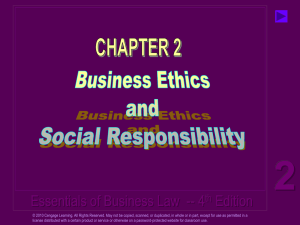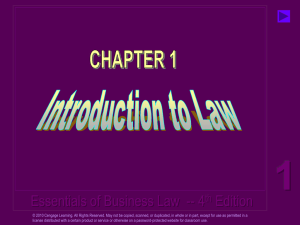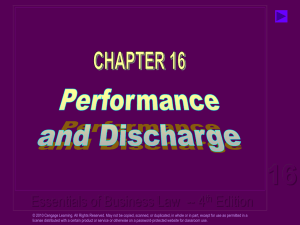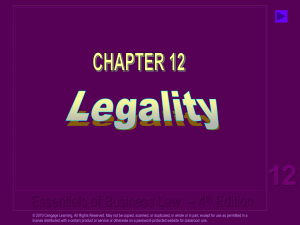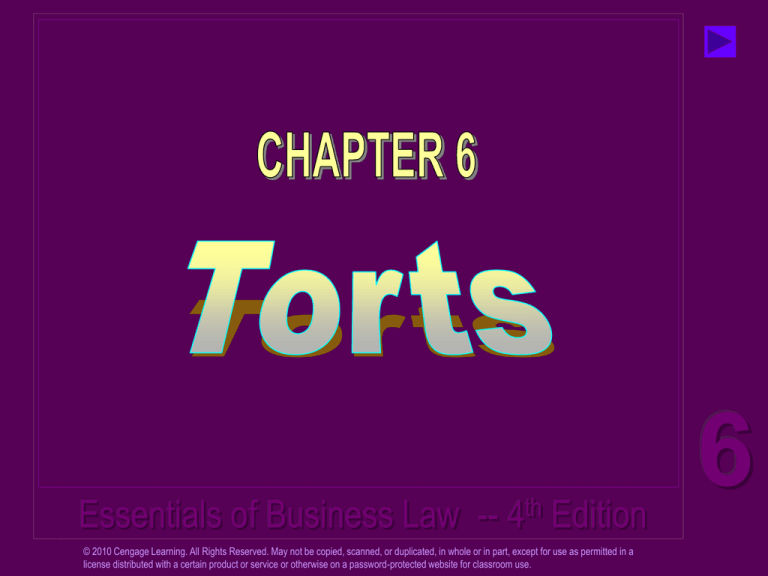
Essentials of Business Law -- 4th Edition
© 2010 Cengage Learning. All Rights Reserved. May not be copied, scanned, or duplicated, in whole or in part, except for use as permitted in a
license distributed with a certain product or service or otherwise on a password-protected website for classroom use.
6
Click your mouse
anywhere on the
screen when you are
ready to advance the
text within each slide.
After the starburst appears behind the blue
triangles, the slide is completely shown.
You may click one of the blue triangles to
move to the next slide or the previous slide.
Essentials of Business Law -- 4th Edition
© 2010 Cengage Learning. All Rights Reserved. May not be copied, scanned, or duplicated, in whole or in part, except for use as permitted in a
license distributed with a certain product or service or otherwise on a password-protected website for classroom use.
6
“The life of the law has not been logic; it has
been experience.”
Oliver Wendell Holmes, Jr.,
Supreme Court Justice
“It is perfectly monstrous the way people go
about nowadays saying things behind one’s
back that are absolutely true.”
Lord Henry, in Oscar Wilde’s The Picture of Dorian Gray
Essentials of Business Law -- 4th Edition
© 2010 Cengage Learning. All Rights Reserved. May not be copied, scanned, or duplicated, in whole or in part, except for use as permitted in a
license distributed with a certain product or service or otherwise on a password-protected website for classroom use.
6
A tort is a violation of a duty imposed by civil law.
Defamation -- making a false statement
about someone - written or verbal
Negligence -- performing wrong surgery
Interference with contract -- stealing a
client away from a competitor
Fraud -- offering to sell something that
doesn’t exist
Essentials of Business Law -- 4th Edition
© 2010 Cengage Learning. All Rights Reserved. May not be copied, scanned, or duplicated, in whole or in part, except for use as permitted in a
license distributed with a certain product or service or otherwise on a password-protected website for classroom use.
6
Criminal Law -- behavior classified as
dangerous to society; prosecuted by the
government, whether victim wants to
prosecute or not; money award goes to the
government
Contract Law -- based on breach of an
agreement between the two parties; victim
prosecutes and receives compensation or
restitution.
Tort Law -- based on an obligation imposed
by the law with no agreement needed
between parties; victim prosecutes and
receives compensation or restitution.
Essentials of Business Law -- 4th Edition
© 2010 Cengage Learning. All Rights Reserved. May not be copied, scanned, or duplicated, in whole or in part, except for use as permitted in a
license distributed with a certain product or service or otherwise on a password-protected website for classroom use.
6
Intentional Torts
• Does not necessarily require an intention to harm
the victim, only an intention to perform the act which
caused the injury. (Intentionally throwing an object,
but not meaning to hit anyone is a tort if it causes
injury to someone.)
• Includes business torts, a category of torts
perpetuated almost exclusively by business entities.
Negligence and Strict Liability
• When a duty is breached and harm results, courts
will examine the facts to determine if there has been
negligence.
Essentials of Business Law -- 4th Edition
© 2010 Cengage Learning. All Rights Reserved. May not be copied, scanned, or duplicated, in whole or in part, except for use as permitted in a
license distributed with a certain product or service or otherwise on a password-protected website for classroom use.
6
Defamation is irresponsible speech to harm
another’s reputation.
• Written defamation is libel.
• Verbal defamation is slander.
There are four facts to prove to win a
defamation suit:
• The defamatory statement was actually made.
• The statement is false.
• The statement was communicated to someone other
than the plaintiff.
• In slander cases, the plaintiff must show some injury
that resulted from the defamation.
Essentials of Business Law -- 4th Edition
© 2010 Cengage Learning. All Rights Reserved. May not be copied, scanned, or duplicated, in whole or in part, except for use as permitted in a
license distributed with a certain product or service or otherwise on a password-protected website for classroom use.
6
Opinion -- to be defamation, the
statement must be provable and not
simply someone’s opinion.
• Vague terms in the statement usually
indicate it is an opinion, not a provable fact.
• Extreme exaggerations are usually not taken
as fact.
Essentials of Business Law -- 4th Edition
© 2010 Cengage Learning. All Rights Reserved. May not be copied, scanned, or duplicated, in whole or in part, except for use as permitted in a
license distributed with a certain product or service or otherwise on a password-protected website for classroom use.
6
Public Personalities
• Includes: public officials (police and politicians) and
public figures (movie stars and other celebrities)
• Public personalities have a harder time winning a
defamation case because they have to prove that the
defendant acted with actual malice.
Internet Service Providers have been held to be
not liable for postings made by their users.
Privilege
• Defendants receive extra protection in special cases.
• In courtrooms and legislatures, speakers have absolute
privilege. They may speak freely, as long as it is true.
• When information is legitimately needed, the speaker
giving it has qualified privilege. This may happen when
someone reports a suspected criminal act.
Essentials of Business Law -- 4th Edition
© 2010 Cengage Learning. All Rights Reserved. May not be copied, scanned, or duplicated, in whole or in part, except for use as permitted in a
license distributed with a certain product or service or otherwise on a password-protected website for classroom use.
6
False imprisonment is the restraint of
someone against their will and without
reasonable cause.
An employer who doesn’t let a sick employee
go home might be guilty of false imprisonment.
If the police detain a person with no reason to
suspect him of any crime, it could be false
imprisonment.
In general, a store may detain a person
suspected of shoplifting if there is a
reasonable basis for the charge and the
detention is done reasonably (in private and
for a reasonable time).
Essentials of Business Law -- 4th Edition
© 2010 Cengage Learning. All Rights Reserved. May not be copied, scanned, or duplicated, in whole or in part, except for use as permitted in a
license distributed with a certain product or service or otherwise on a password-protected website for classroom use.
6
Intentional Infliction
of Emotional Distress
Historically, no recovery was allowed if the
injury was only emotional instead of physical.
Today, most courts allow a plaintiff to recover
from a defendant who intentionally causes
emotional injury.
• Behavior causing injury must be extreme and
outrageous.
• Must have caused serious emotional harm.
Some courts allow recovery for emotional
injury caused by negligent behavior.
Essentials of Business Law -- 4th Edition
© 2010 Cengage Learning. All Rights Reserved. May not be copied, scanned, or duplicated, in whole or in part, except for use as permitted in a
license distributed with a certain product or service or otherwise on a password-protected website for classroom use.
6
Battery is a touching of another person in a
way that is unwanted or offensive.
• The touch does not have to hurt the victim -- sexual
touching that is offensive, but not painful, is battery.
• An intentional action that does hurt someone may
be battery even if the injury is unintentional.
Assault is an action that causes the victim to
fear an imminent battery.
• Assault can occur without battery ever happening.
• Pulling a gun on someone -- even if it is unloaded -is usually considered assault.
Fraud is injuring another person by deliberate
deception.
Essentials of Business Law -- 4th Edition
© 2010 Cengage Learning. All Rights Reserved. May not be copied, scanned, or duplicated, in whole or in part, except for use as permitted in a
license distributed with a certain product or service or otherwise on a password-protected website for classroom use.
6
A jury may award compensatory damages -payment for injury --to a plaintiff who prevails in
a civil suit.
The Single Recovery Principle mandates that the
court must decide all damages -- past, present
and future -- at one time and settle the matter
completely.
Damages may include money for three
purposes:
• to restore any loss (such as medical expenses)
caused by the illegal action
• to restore lost wages if the injury kept the defendant
from working
• to compensate for pain and suffering
Essentials of Business Law -- 4th Edition
© 2010 Cengage Learning. All Rights Reserved. May not be copied, scanned, or duplicated, in whole or in part, except for use as permitted in a
license distributed with a certain product or service or otherwise on a password-protected website for classroom use.
6
While the purpose of compensatory damages
is to help the victim recover what was lost,
punitive damages are intended to punish the
guilty party.
• Intended for conduct that is outrageous and extreme
• Designed to “make an example” out of the defendant
• Should deter others from doing same conduct and
prevent this defendant from repeating actions
Sometimes punitive damage awards are huge,
but in most cases they are close to or less
than the amount of compensatory damages
awarded.
Essentials of Business Law -- 4th Edition
© 2010 Cengage Learning. All Rights Reserved. May not be copied, scanned, or duplicated, in whole or in part, except for use as permitted in a
license distributed with a certain product or service or otherwise on a password-protected website for classroom use.
6
Business Torts
Intentional torts that occur almost exclusively
in a business setting are called business torts.
Interference with business relations
• Interference with a contract
• Interference with a prospective advantage
The rights to privacy and publicity
• Intrusion
• Commercial exploitation
Essentials of Business Law -- 4th Edition
© 2010 Cengage Learning. All Rights Reserved. May not be copied, scanned, or duplicated, in whole or in part, except for use as permitted in a
license distributed with a certain product or service or otherwise on a password-protected website for classroom use.
6
Interference with a contract exists if the
plaintiff can prove these elements:
• There was a contract between the plaintiff
and a third party and the defendant knew of
the contract.
• The defendant induced the third party to
breach the contract or make performance
impossible.
• There was injury to the plaintiff.
Essentials of Business Law -- 4th Edition
© 2010 Cengage Learning. All Rights Reserved. May not be copied, scanned, or duplicated, in whole or in part, except for use as permitted in a
license distributed with a certain product or service or otherwise on a password-protected website for classroom use.
6
Interference with prospective advantage
exists:
• when there is a relationship which gives the
plaintiff a reasonable expectation of
economic advantage, even though no
contract exists
• when the defendant maliciously interferes
and prevents the relationship from
developing
Essentials of Business Law -- 4th Edition
© 2010 Cengage Learning. All Rights Reserved. May not be copied, scanned, or duplicated, in whole or in part, except for use as permitted in a
license distributed with a certain product or service or otherwise on a password-protected website for classroom use.
6
Intrusion (prying into someone’s private life) is
a tort if a reasonable person would find it
offensive.
• Examples: wiretapping, stalking, peeping
• Would this include buying your personal information
from your credit card company?
a person’s image or voice is used for
commercial purposes without that person’s
permission.
Essentials of Business Law -- 4th Edition
© 2010 Cengage Learning. All Rights Reserved. May not be copied, scanned, or duplicated, in whole or in part, except for use as permitted in a
license distributed with a certain product or service or otherwise on a password-protected website for classroom use.
6
“The Unintentional Tort”
To win a negligence case, the plaintiff must
prove that the defendant failed in five areas:
Duty of due care -- there must be a duty
owed to the plaintiff.
Breach -- duty must be breached.
Factual cause -- the injury must have been
caused by the defendant’s actions.
Foreseeable harm -- it must have been
foreseeable that the action would cause
this kind of harm.
Injury -- the plaintiff must have been hurt.
Essentials of Business Law -- 4th Edition
© 2010 Cengage Learning. All Rights Reserved. May not be copied, scanned, or duplicated, in whole or in part, except for use as permitted in a
license distributed with a certain product or service or otherwise on a password-protected website for classroom use.
6
Duty of Due Care
If a defendant could have foreseen
injury to a particular person, she has a
duty to him.
• In some states, a social host serving
alcohol to an adult may be found liable for
harm done by the person drinking the
alcohol.
• Many states have a “dram act,” making
liquor stores, bars and restaurants liable
for serving drinks to intoxicated
customers who later cause harm.
Essentials of Business Law -- 4th Edition
© 2010 Cengage Learning. All Rights Reserved. May not be copied, scanned, or duplicated, in whole or in part, except for use as permitted in a
license distributed with a certain product or service or otherwise on a password-protected website for classroom use.
6
Breach of Duty
A defendant breaches his duty of due care by
failing to behave the way a reasonable person
would under similar circumstances.
Companies and Employees -- courts have
found companies liable for hiring and retaining
employees known to be violent, when those
employees later injured co-workers.
Negligence per se -- in special cases,
legislatures set a minimum standard for
certain groups of people (esp. children).
When a violation of that statute hurts a
member of that group, the duty is breached.
Essentials of Business Law -- 4th Edition
© 2010 Cengage Learning. All Rights Reserved. May not be copied, scanned, or duplicated, in whole or in part, except for use as permitted in a
license distributed with a certain product or service or otherwise on a password-protected website for classroom use.
6
Factual Cause & Foreseeable Harm
Factual Cause -- if the defendant’s breach
ultimately led to the injury, he is liable.
• Does not have to be the immediate cause of
injury, but must be the first in the direct line.
Foreseeable Harm -- to be liable, this type
of harm must have been foreseeable.
• The defendant does not have to know exactly
what would happen -- just the type of event.
Res Ipsa Loquitur -- in a few cases, the
defendant must prove he was NOT
negligent or the facts imply that his
negligence caused the injury.
Essentials of Business Law -- 4th Edition
© 2010 Cengage Learning. All Rights Reserved. May not be copied, scanned, or duplicated, in whole or in part, except for use as permitted in a
license distributed with a certain product or service or otherwise on a password-protected website for classroom use.
6
DO NOT CLICK! Let slide “build” on its own.
Mechanic fails
to fix customer’s
brakes, which
causes...
Car
accident,
car hitting
bicyclist
Car accident,
car
does not hit
bicyclist
Car
accident,
car hitting
bicyclist
Noise from
accident startles
someone who falls
out a window
Bicyclist hits
pothole and
crashes
Mechanic is
liable to
cyclist
Mechanic is
NOT liable
for falling
person
Mechanic is
NOT liable
to cyclist
Factual
cause and
foreseeable
type of injury
Factual
cause, but
no
foreseeable
type of injury
No
factual
cause
Essentials of Business Law -- 4th Edition
© 2010 Cengage Learning. All Rights Reserved. May not be copied, scanned, or duplicated, in whole or in part, except for use as permitted in a
license distributed with a certain product or service or otherwise on a password-protected website for classroom use.
6
Injury & Damages
Injury -- plaintiff must show genuine injury
• Future injury may be compensated, but must
be determined at the time of trial.
Damages -- are usually compensatory,
designed to restore what was lost. In
unusual cases, they may be punitive.
Essentials of Business Law -- 4th Edition
© 2010 Cengage Learning. All Rights Reserved. May not be copied, scanned, or duplicated, in whole or in part, except for use as permitted in a
license distributed with a certain product or service or otherwise on a password-protected website for classroom use.
6
Contributory Negligence
• In a few states, if the plaintiff is AT ALL
negligent, he cannot recover damages from
the defendant.
Comparative Negligence
• In most states, if the plaintiff is negligent, a
percentage of negligence is applied to both
the defendant and the plaintiff.
• The plaintiff can recover from the defendant to
the percentage that the defendant is negligent.
• In some cases, a plaintiff found to be more
than 50% negligent cannot recover at all.
Essentials of Business Law -- 4th Edition
© 2010 Cengage Learning. All Rights Reserved. May not be copied, scanned, or duplicated, in whole or in part, except for use as permitted in a
license distributed with a certain product or service or otherwise on a password-protected website for classroom use.
6
A person who voluntarily enters a
situation that has an obvious danger
cannot complain if she is injured.
• This rule applies to a situation where the
danger is well-known and the participant
chooses to be present.
Essentials of Business Law -- 4th Edition
© 2010 Cengage Learning. All Rights Reserved. May not be copied, scanned, or duplicated, in whole or in part, except for use as permitted in a
license distributed with a certain product or service or otherwise on a password-protected website for classroom use.
6
Some activities are so dangerous that the law imposes
a high burden on them. This is called strict liability.
Defective Products-- may incur strict liability.
Ultrahazardous Activities -- defendants are
virtually always held liable for harm.
• What is ultrahazardous? Includes using harmful
chemicals, explosives and keeping wild animals.
• Plaintiff does not have to prove breach of duty or
foreseeable harm.
• Comparative negligence does not apply -defendant engaging in ultrahazardous activity is
wholly liable.
Essentials of Business Law -- 4th Edition
© 2010 Cengage Learning. All Rights Reserved. May not be copied, scanned, or duplicated, in whole or in part, except for use as permitted in a
license distributed with a certain product or service or otherwise on a password-protected website for classroom use.
6
Essentials of Business Law -- 4th Edition
© 2010 Cengage Learning. All Rights Reserved. May not be copied, scanned, or duplicated, in whole or in part, except for use as permitted in a
license distributed with a certain product or service or otherwise on a password-protected website for classroom use.
6


